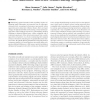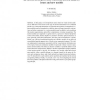521 search results - page 51 / 105 » Learning By Observation Using Qualitative Spatial Relations |
GIS
1992
ACM
13 years 11 months ago
1992
ACM
Machine learning techniques such as tree induction have become accepted tools for developing generalisations of large data sets, typically for use with production rule systems in p...
NIPS
2007
13 years 9 months ago
2007
Traditional analysis methods for single-trial classification of electroencephalography (EEG) focus on two types of paradigms: phase locked methods, in which the amplitude of the ...
JOCN
2010
13 years 2 months ago
2010
Maintaining spatial orientation while travelling requires integrating spatial information encountered from an egocentric viewpoint with accumulated information represented within ...
BMVC
2010
13 years 5 months ago
2010
In this paper we address the problem of recognising interactions between two people in realistic scenarios for video retrieval purposes. We develop a per-person descriptor that us...
SCVMA
2004
Springer
14 years 1 months ago
2004
Springer
Abstract. In this paper, several important issues related to visual motion analysis are addressed with a focus on the type of motion information to be estimated and the way context...


